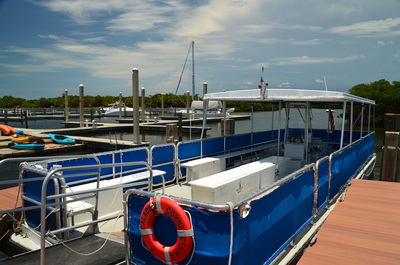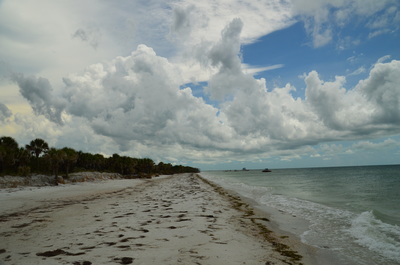
Most Florida islands with beaches have become developed, due to beaches acting as a magnet for vacationers and resort developments. Luckily, Caladesi Island - a barrier island off the coastline of Pinellas County - was purchased by the state of Florida. It is now accessible only by boat or ferry, or by a long walk along the beach from Clearwater Beach through sand-filled Dunedin Pass. Today, we have a couple of miles of undisturbed beaches on the island, as well as a several-mile hiking trail that leads through the island scrub and into a hammock where you will get to see the Scharrer Homestead. That is, if you're brave enough to face the mosquitoes. This hike occurred on Sunday, June 26th, 2016. My plan was to take the ferry from Honeymoon Island to Caladesi Island in order to hike the trail system on Caladesi Island. From the ferry dock, I would take the Island Trail to the Hammock Loop. Then, I would hike the Hammock Loop, as well as the spur trail to the Scharrer Homestead, before taking the Beach Trail and then returning to the ferry dock via the beach.
Summary
R/T Length of Trail: 3.9 Miles
Duration of Hike: 2:45 Type of Hike: Double Loop with Extension Difficulty Rating: 1 out of 10 Total Elevation Gain: Minimal Pros: None Cons: Mobs of mosquitoes in the island's hammock at least during summer Points of Interest: The Twin Pine; Ruins of the Scharrer Homestead; Freshwater pond; Views of Dunedin Pass; Cat's Eye Pond Trail Blaze Color(s): None Best Season(s) to Hike: Winter Fees: There is a $8 entrance fee to Honeymoon Island State Park for vehicles with 2-8 passengers, and a $4 fee for single occupant vehicles. Then, there is a fee for the Caladesi Island Ferry. The ferry fee is $14 per adult and $7 per child (ages 6-12). Children that are younger than 6 years old are allowed for free on the ferry. Also, dogs are not allowed on the ferry. Beginning Point: Ferry terminal on Caladesi Island Directions from Dunedin, FL: Follow US 19 Alternate Route North to the intersection with FL State Route 586 (Causeway Boulevard). Here, turn left onto Causeway Boulevard. Continue for 3.3 miles across the bridge to Honeymoon Island. After 3.3 miles, enter Honeymoon Island State Park. After paying your fee, continue for 0.1 miles farther, and then, turn left onto the road to ferry terminal. Reach the huge Caladesi Island Ferry parking area in 0.2 miles. From here, walk to the booth at the upper right end of the parking area. Pay the ferry fee here, and walk the boardwalk to the ferry terminal. Wait here until you're given a signal to get on board the ferry. The ferry ride is about 10 minutes long, The ferry follows a route to the east of Hurricane Pass and into a mangrove maze near the northeast end of Caladesi Island, where the Caladesi Island terminal is located. Leave the ferry here and begin your hike. Your return time should be on the ticket that you were given, although a ferry runs back and forth every 30 minutes during summer and every hour during winter. You are allowed to spend up to 4 hours on the island. Map
Click here for more information and to download this trail map to view in Garmin Basecamp.
Details
It felt great to be back in Florida for the summer. I had been looking forward to over a month of hiking in Florida for quite some time, but the hike that I chose to begin with proved to be not the best. It wasn't too bad, but the mosquitoes absolutely ruined it. I've never seen so many mosquitoes on any of my hikes, including all of my other Florida hikes combined. For this reason, I do not recommend hiking on the island during summer, which is a shame considering that summer is a good time to cool off at the island's beach after the hike. At least, I hope that there's no mosquitoes during other times of the year.
At first, I was at a loss as to where to start the hike - the simple idea of walking through the ranger station building had eluded me. The ranger station is located directly in front of the ferry terminal. The access trail to the main trail system begins as a paved path behind the ranger station. There is a sign that warns you about the island's rattlesnake population. I think that they should have placed one about the mosquitoes too! Quite shortly, the paved path reaches a sign marking the beginning of the Island Trail. The paved path continues straight to a boardwalk to the beach. At the junction with the Island Trail, you can see the overgrown remains of an old fire tower. All that is left is the concrete foundation. As I turned left onto the Island Trail, I noticed my first gopher tortoise of the day, crawling into the palmettos to the trail's left. A few feet farther, a large sign shows a sketch of the Island Trail along with key information about it. After this, the wide, sandy trail takes off into the island scrub. Lined by palms and palmettos, the trail is pretty much out in the open under the blazing sun. 0.15 miles from the beginning, the trail crosses a wide route that connects the park service road to the beach. Throughout the first part of the Island Trail, the hike remains pretty much the same. At one point, the trail passes a neat cabbage palm that has a long horizontal trunk just above the ground, until the trunk suddenly shoots up towards the sky and the crown of the tree. At 0.6 miles, the trail reaches an intersection with a shortcut that leads to the right to Cat's Eye Pond and the beach. Continue straight on the Island Trail that leaves the open land and enters the shade of the hammock. Normally, the shade would've been cool and refreshing, but on this day, I didn't welcome it heartily, for the amount of mosquitoes increased twofold. The trail winds along the edge of the hammock, passing the remains of old mosquito control ditches, which may have standing water in them. At 1 mile, the Island Trail ends at a four-way junction. Straight ahead,the Beach Trail continues to Cat's Eye Pond - you'll take this trail later on. The Hammock Loop turns to the left, splitting a few feet farther, with one part of it going left again and the other part continuing straight. I turned left onto the Hammock Loop, and then, I turned left again, in order to hike the loop clockwise. Passing through a controlled burn area, the Hammock Loop crosses the main service road at 1.1 miles. Shaded by sand oaks, the Hammock Loop leaves the controlled burn area and reaches the Twin Pine at 1.25 miles. There is also a great deal of information about the Scharrer homestead here, which I will explain in detail a bit later. At 1.3 miles, the trail reaches what seems like a service road. Actually, if you turn left here, you'll reach the ruins of the Scharrer Homestead. For some reason, the spur trail isn't marked. I think that on some map I saw this spur trail marked as the Cedar Grove Trail, but I'm not sure of this, for I can't locate the map. Regardless, turn left to do the side trip to the homestead. This is a pretty stretch of trail due to the Spanish moss that the oaks' branches are draped in. As I approached the homestead ruins, I saw my second gopher tortoise of the day. Interestingly, while the tortoise is endangered, I actually saw many of them during the time that I spent in Florida. The spur trail ends at the Scharrer homestead ruins at 1.75 miles.
This homestead was occupied by Henry Scharrer from 1892 to 1934. Scharrer was an immigrant from Sweden, who decided to move to the US. He ended up settling Caladesi Island and spending the rest of his life there. When he moved there, the island became known as Hog Island, and later on, a hurricane split Hog Island in two, resulting in the Honeymoon Island, Hurricane Pass, and Caladesi Island that we see today. Henry Scharrer's home was pillaged and burned in 1934, when Henry himself was hospitalized in Dunedin. Scharrer died from his illness, at an age 74, in part due to his grief after he learned that his beloved island home was gone. After his death, several other people lived on the island, but for not as long as Henry Scharrer did. In 1967, Caladesi Island became a Florida State Park, and today, the stone ruins that you see are all that is left of the once thriving Scharrer house. All that remains is a couple of stone foundations, various stone rubble, and portions of a chimney.
From the homestead, retrace your steps to the Hammock Loop, returning to it at 2.2 miles. Turn left onto the Hammock Loop. Shortly afterwards, you will pass a freshwater pond to the left, a surprising scene on an island surrounded by saltwater. A fallen palm lies across the small pond, and a large oak shades it overhead. The trail soon returns into the controlled burn area, crossing the service road again at 2.3 miles. By turning left onto the service road, one could follow it all the way to the south end of Caladesi Island, where there must be good vies of Dunedin Pass and the surrounding areas. However, I do not think that foot traffic is allowed or at least encouraged on the service road. Just beyond the service road, a short path to the left leads to a small sandy strip along the upper reaches of Dunedin Pass. From here, you can see the mangrove-lined bay and residential constructions on Clearwater Beach just to the south. The Hammock Loop continues past the views of Dunedin Pass and back north to the four-way junction, reaching it at 2.65 miles. By now, there was a huge cloud of mosquitoes weaving around me, and I was taking less and less pictures due to the fact that it was simply impossible to stop. I had to make up my mind to begin jogging on the rest of the hike to the beach, in order to get at least less mosquito bites! Regardless, I had a decision to make here. I could continue on the Island Trail and return the same way as I came here, or I could take the Beach Trail and then finish the hike along the beach. I opted for the Beach Trail, because I knew that once I would get to the beach, the sea breeze would prevent any mosquitoes from following me further. And in any case, the beach route is more scenic, as you get to see Cat's Eye Pond and then walk along the beach with grand views of the Gulf of Mexico. Turn left onto the Beach Trail. This trail widens to the size of a small service road as it heads northwest and then north towards Cat's Eye Pond, following a mangrove-lined canal. At 3 miles, the shortcut from the Island Trail comes in from the right .It is marked by the signs "Nature Trail ^ " and "Ranger Station ^ ". Afterwards, the trail bends westward and crosses the canal via a broad bridge. To the right of the bridge, you can see a mangrove-lined saltwater lagoon. This is Cat's Eye Pond. The bridge offers the best view of this lagoon. Following the bridge, the trail heads northwest into thinning forest with scattered palm trees, until it approaches the beach and a sign that states "No Dogs Beyond This Point". At 3.1 miles, the Beach Trail ends at the Caladesi Island Beach, where a Nature Trail sign marks the trail entrance.
By the time you're at the beach, you will probably still have plenty of time left before your return time. Thus, before you wrap up the hike, You can stay on the beach for a bit and perhaps even go in the ocean for a cool-off after the hot hike. After you've taken a break, begin following the beach northward. Follow the beach northward for 0.6 miles, until you reach the second boardwalk to the right at the busiest section of the beach. This boardwalk leads back to the ranger station and the ferry terminal. Turn right onto the boardwalk. Reach the ranger station and ferry terminal at 3.9 miles, concluding the hike. Once you're back at the ferry terminal, board it at the given signal and ride back to Honeymoon Island.
This 4-mile hike wasn't quite enough to satisfy me for the day, so I completed another short hike on Honeymoon Island after this one. It will be described in the next trail report. Oh yeah - mercifully, there was less mosquitoes on Honeymoon Island! Mileage
0.0 - Caladesi Island Ferry Terminal
1.0 - Four-way junction with Hammock Loop 1.25 - Twin Pine 1.75 - Henry Scharrer homestead 2.25 - Freshwater pond 2.65 - Reach four-way junction a second time 3.0 - Cat's Eye Pond 3.1 - Caladesi Island Beach 3.9 - Caladesi Island Ferry Terminal Variations
Return along the Island Trail instead of Beach Trail - 3.65 Miles
Bonus Stops
The Honeymoon Island trail system is an excellent add-on to this hike. I decided to hike it myself after doing the Caladesi Island hike.
PicturesVideos
4 Comments
Wow, I just went in February and encountered exactly zero mosquitoes. I guess I picked the right time of year. I never saw anything about the homestead at all, and the trails towards the southern end became a little bit confusing. I missed cedar grove trail entirely and ended up on a service road for a ways before I realized I was going the wrong way. Everything around there was a restricted area!
Reply
5/28/2017 09:50:53 am
Hi Mark,
Reply
Leave a Reply. |
About MeMark Oleg Ozboyd Dear readers: I have invested a tremendous amount of time and effort in this website and the Georgia Waterfalls Database the past five years. All of the work that has gone in keeping these websites updated with my latest trip reports has almost been like a full-time job. This has not allowed me to pick up a paid job to save up money for college, and therefore, I I've had to take out loans. If you find the information on this website interesting, helpful, or time-saving, you can say "thanks" and help me out by clicking the button above and making a contribution. I will be very grateful for any amount of support you give, as all of it will apply toward my college tuition. Thank you!
Coming in 2022-2023?
Other Hiking WebsitesMiles HikedYear 1: 540.0 Miles
Year 2: 552.3 Miles Year 3: 518.4 Miles Year 4: 482.4 Miles Year 5: 259.9 Miles Archives
March 2021
Categories
All
|






























 RSS Feed
RSS Feed